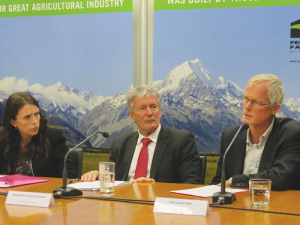DairyNZ and Beef + Lamb NZ wrap up M. bovis compensation support after $161M in claims
Compensation assistance for farmers impacted by Mycoplama bovis is being wound up.
 Prime Minister Jacinda Ardern, Agriculture Minister Damien O’Connor and DairyNZ chair Jim van der Poel addressing the media conference at Federated Farmers headquarters in Wellington last week that outlined the joint industry-government decision to go for a phased eradication of the cattle disease Mycoplasma bovis.
Prime Minister Jacinda Ardern, Agriculture Minister Damien O’Connor and DairyNZ chair Jim van der Poel addressing the media conference at Federated Farmers headquarters in Wellington last week that outlined the joint industry-government decision to go for a phased eradication of the cattle disease Mycoplasma bovis.
One person describes eradicating Mycoplasma bovis as like “trying to build an aeroplane while it is still flying” and there is some truth in that.
Government, industry to eradicate M. bovis at a cost of $886m.
The tracing procedures are difficult, the tests complex and prevention at this stage is not easy.
Neither the Prime Minister, the Minister of Agriculture, nor any MPI official or industry representative, at last week’s announcement of the eradication campaign, would put their hand on their heart and say the plan will succeed.
Their line was, “we think we have discovered it early in the piece so we need to have a shot at eradication” – rather than effectively doing nothing and just managing it as most countries do.
Eradication will see at least 150,000 animals slaughtered – possibly more – over two years and at least 192 properties will have their animals slaughtered with still no guarantee of success.
The $886 million cost will be shared between the Government and the industry, namely DairyNZ and Beef + Lamb NZ who support the plan.
The Government will meet 68 % of the cost, and DNZ and BLNZ 32%. Money from these two industry organisations will come from a special biosecurity levy linked to their Government Industry Arrangement (GIA) on biosecurity.
Money from standard commodity levies that are used to fund DairyNZ and BLNZ cannot be used to fund biosecurity, so a special levy will be made, as approved by farmers in the GIA consultation process.
Rural News understands that the details of how this special levy will be collected and which organisation will pay what amount is still being worked out. However, it’s believed that in general the dairy industry will pay more by virtue of the fact that it has more cows than the beef sector.
It’s also believed that, in the first instance, the Government will pay the up-front cost of eradication. DairyNZ and B+LNZ will repay this over time on the basis that the levy collected from farmers will not be too big in the first two years of the eradication.
Three New Zealand agritech companies are set to join forces to help unlock the full potential of technology.
As the sector heads into the traditional peak period for injuries and fatalities, farmers are being urged to "take a moment".
Federated Farmers says almost 2000 farmers have signed a petition launched this month to urge the Government to step in and provide certainty while the badly broken resource consent system is fixed.
Zespri’s counter-seasonal Zespri Global Supply (ZGS) programme is underway with approximately 33 million trays, or 118,800 tonnes, expected this year from orchards throughout France, Italy, Greece, Korea, and Japan.
Animal owners can help protect life-saving antibiotics from resistant bacteria by keeping their animals healthy, says the New Zealand Veterinary Association.
According to analysis by the Meat Industry Association (MIA), New Zealand red meat exports reached $827 million in October, a 27% increase on the same period last year.